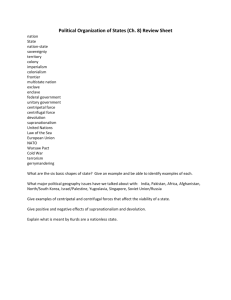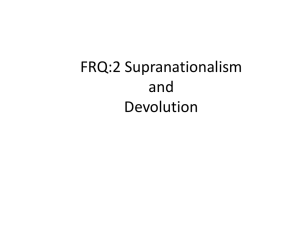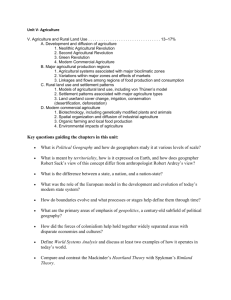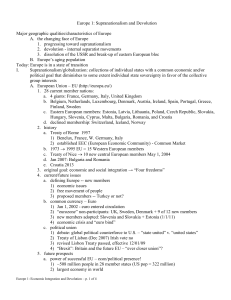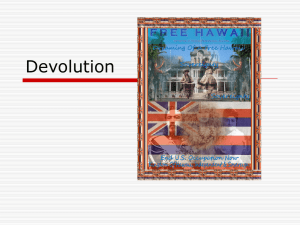Outline Europe 1- Supranationalism and Devolution
advertisement
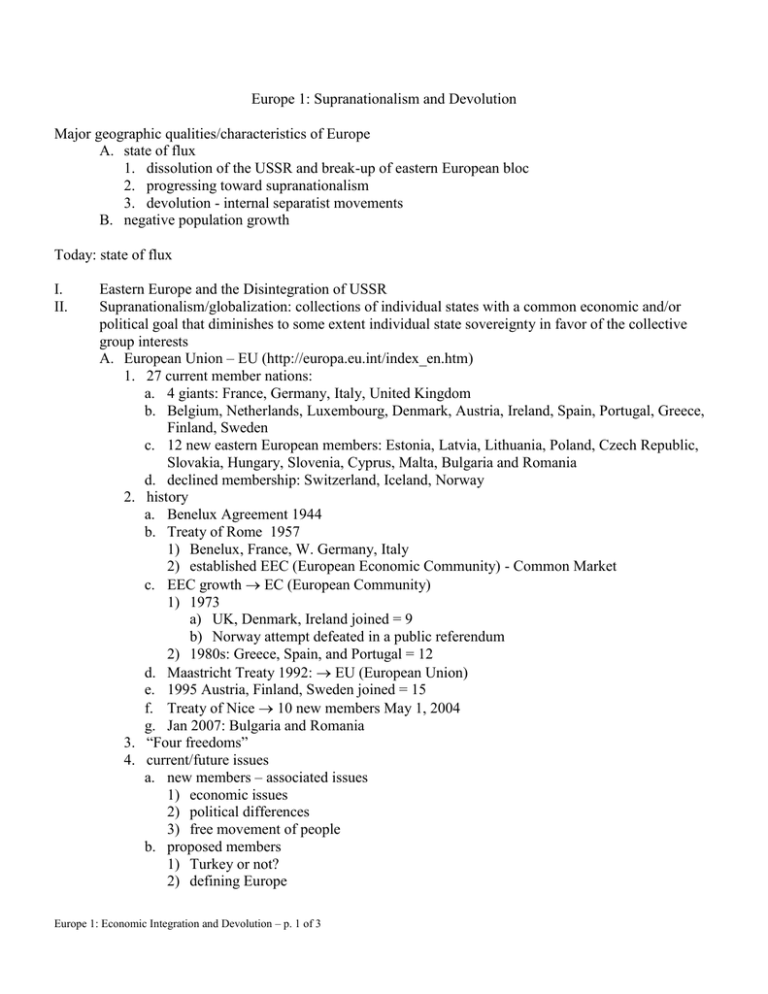
Europe 1: Supranationalism and Devolution Major geographic qualities/characteristics of Europe A. state of flux 1. dissolution of the USSR and break-up of eastern European bloc 2. progressing toward supranationalism 3. devolution - internal separatist movements B. negative population growth Today: state of flux I. II. Eastern Europe and the Disintegration of USSR Supranationalism/globalization: collections of individual states with a common economic and/or political goal that diminishes to some extent individual state sovereignty in favor of the collective group interests A. European Union – EU (http://europa.eu.int/index_en.htm) 1. 27 current member nations: a. 4 giants: France, Germany, Italy, United Kingdom b. Belgium, Netherlands, Luxembourg, Denmark, Austria, Ireland, Spain, Portugal, Greece, Finland, Sweden c. 12 new eastern European members: Estonia, Latvia, Lithuania, Poland, Czech Republic, Slovakia, Hungary, Slovenia, Cyprus, Malta, Bulgaria and Romania d. declined membership: Switzerland, Iceland, Norway 2. history a. Benelux Agreement 1944 b. Treaty of Rome 1957 1) Benelux, France, W. Germany, Italy 2) established EEC (European Economic Community) - Common Market c. EEC growth EC (European Community) 1) 1973 a) UK, Denmark, Ireland joined = 9 b) Norway attempt defeated in a public referendum 2) 1980s: Greece, Spain, and Portugal = 12 d. Maastricht Treaty 1992: EU (European Union) e. 1995 Austria, Finland, Sweden joined = 15 f. Treaty of Nice 10 new members May 1, 2004 g. Jan 2007: Bulgaria and Romania 3. “Four freedoms” 4. current/future issues a. new members – associated issues 1) economic issues 2) political differences 3) free movement of people b. proposed members 1) Turkey or not? 2) defining Europe Europe 1: Economic Integration and Devolution – p. 1 of 3 III. c. common currency - Euro 1) non-participants: UK, Sweden, Denmark + 11 new members (Slovenia exception) 2) Jan 1, 2002 - euro entered circulation 3) Jul 1, 2002 - local currencies no longer accepted d. constitution - political power 1) reorganization -- power apportionment 2) drafted 2004; referendums 2005 → "period of reflection" 3) June 2007 compromises 4) “states united” v. “united states of Europe” 5. future prospects a. power of successful EU – econ/political presence! 1) 500 million people in 27 member states (US pop = 300 million) 2) 26% of world trade 3) euro challenge to dollar b. Euroskeptics fear Eurofication c. historical antagonists B. NATO (North Atlantic Treaty Organization) 1. history a. formed 1950: collective defense b. Soviet response: Warsaw Pact c. until 1999: USA + Canada + 14 European (UK, France, Germany, Benelux, Denmark, Norway, Iceland, Portugal, Spain, Italy, Greece, Turkey) d. currently: 24 European countries + USA + Canada 2. NATO expansion w/1991 Soviet collapse a. admissions 3/99: Poland, Hungary, Czech Republic b. admissions 3/04: Bulgaria, Estonia, Latvia, Lithuania, Romania, Slovakia, Slovenia Devolution -- increased tribalism A. regions within a state demand and gain political strength and growing autonomy at the expense of the central government B. examples of devolution 1. former Yugoslavia a. historical geographical context: 1) physical geography 2) relative location: zone of politico-geographical splintering and fracturing 3) birth of Yugoslavia 4) Tito 5) devolution of USSR b. ethnic and religious divisions: Serbs (Eastern Orthodox), Croats (Roman Catholic), Muslim Slavs c. Slovenia, Croatia, Macedonia, Bosnia-Herzegovina, Serbia, and Montenegro d. Kosovo: Serbs v. ethnic Albanians e. balkanization: the fragmentation of a region into smaller, often hostile units 2. Czechoslovakia - cordial 1993 separation a. Czech Republic b. Slovakia 3. other European areas experiencing devolutionary forces Europe 1: Economic Integration and Devolution – p. 2 of 3 a. United Kingdom 1) Northern Ireland 2) Scotland 3) Wales b. Spain 1) Basque (Pyrenees) and Catalonia - autonomy agreements 2) Barcelona 4. North America - could it happen here? IV. Europe’s future?!? Supranationalism or Devolution??! ****************************************************************** Integration/Devolution Exercise ****************************************************************** Next Class: Europe Geography Bowl pp. 1-290; 312-342 Europe 1: Economic Integration and Devolution – p. 3 of 3
